Many people believe that the way our face grows is entirely genetic… but what if I told you this is not actually true?
In fact, facial form is impacted significantly by environmental forces (1).
The demand for Orthodontic treatment is increasing as the prevalence of malocclusion (crooked teeth) continues to rise each year (see figure below). In fact, the global Orthodontics market is expected to reach a staggering $6,035 million by 2023 (2).

Orthotropics is a controversial topic as it goes against what is currently being taught and practiced in traditional Orthodontics. This is one of the reasons why many people have not heard about this concept before.
The truth is, If the claims behind Orthotropics and mewing are proven to be correct, then it would be very detrimental to the Orthodontic profession.
For over a decade, Dr. Mike Mew has been trying to spark a public discussion/debate on the cause of malocclusion (3). Unfortunately, no one in his profession seems to be interested in doing so (4).
Like most things in life, there is always going to be some resistance to change, but there should not be nearly as much as there has been with the Mew family.

Here are some statistics that you should be made aware of:
- 95% of people have deviations in their dental alignment (5)
- >30% of people are recommended Orthodontic treatment (6)
- 7.5-15% of people are recommended premolar extractions (7)
- Nearly 50% of all wisdom teeth are removed (8)
As you can see, these figures are quite staggering. Now compare these numbers to our ancestors, who had:
There has to be a reason behind this change… right?
Ideally, we should all be getting horizontal growth, but instead, we have been getting predominantly vertical growth (as illustrated in the image below) (11).
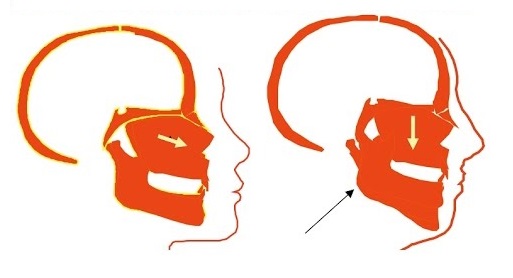
Dr. Mew is simply trying to raise awareness around this topic. He is not trying to sell anyone anything or promote any of his services. He just wants to know the truth.
If we know the cause behind crooked teeth, then we can figure out a way to prevent it from happening.
We shouldn’t be focusing on treatment, we should be focusing on prevention.
What Causes Crooked Teeth?
One of the biggest mysteries of this day in age is ‘what causes crooked teeth?’
Unfortunately, the exact cause of crooked teeth is currently unknown.
Genetics obviously play a role in malocclusion, but research has shown that the modern lifestyle is a more important factor contributing to this problem (12).
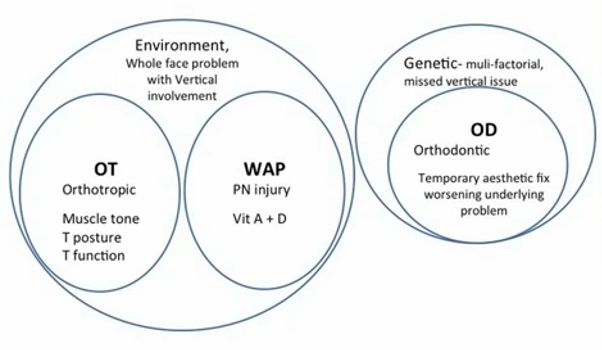
Orthodontists believe that the cause of malocclusion is multifactorial, which Dr. Mew believes is just a classic modern excuse (13).
The orthodontic profession openly admits that they do not know the exact cause of crooked teeth (14). Many research papers have found that there is a strong correlation between crooked teeth and environmental factors, which suggests that crooked teeth is actually an acquired disease (15).
Weston Price, a well-recognized dentist, thought that malocclusion may be influenced by prenatal injury, or Vitamin A or Vitamin D deficiency (16). Unfortunately, there has been no hard evidence to suggest that either of these claims are true (17)
The Orthotropic community believes that the reason behind increasing malocclusion over the years is due to the changes in muscle tone, tongue posture, and tongue function (18).
There are three different areas that have changed significantly over the years, which may explain why crooked teeth is becoming more common (19). This includes:
- Diet (hard foods to soft foods)
- Change in oral posture (nasal obstruction is becoming increasingly prevalent) (20)
- Reduction in the duration of breastfeeding / early introduction of soft foods (21)
What is Orthotropics?
Orthotropics is a concept that was invented by Professor John Mew in 1966 that expands on some of the ideas and principles that were established by his Father before him (22). Orthotropics essentially means straight or correct growth and is based on the Tropic Premise.
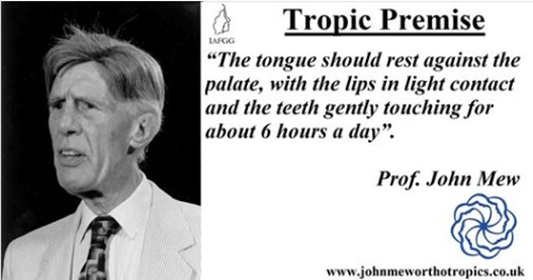
The Tropic Premise looks at the way you should hold your mouth (the tongue, the lips, and the position of the jaw) (23). The idea behind the Tropic Premise is that you should look to maintain the following position for 4 to 8 hours a day (24):
- Tongue pressed up against the palate
- Lips closed
- Teeth touching gently together
In theory, If you can do all of these things correctly, then your face and jaw will grow correctly. There should also be enough room for all 32 of your teeth to grow (25).
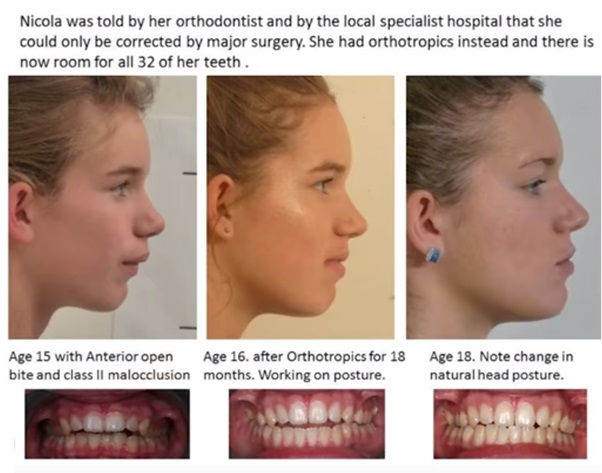
Orthotropics differs from Orthodontics in that Orthotropics aims to correct growth while Orthodontics aims to straighten teeth (26). The problem with Orthodontics is that while it may give you straighter teeth, it is known to have a negative effect on the appearance of the face (27).
For those of you who are unaware, Orthotropics is derived from the Greek terms Ortho (straight/proper) and Tropics (growth).
Below is an image of two identical twins who received two different types of treatment in order to correct their dental alignment. The first boy (pictured above) had premolar extractions, while the second boy (pictured below) had Orthotropic treatment. As you can see, Orthotropic treatment had a drastic change on the way this boy’s face grew (28).
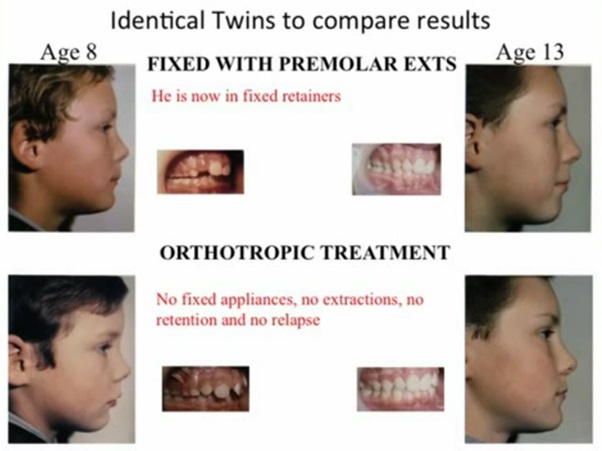
Orthodontics always makes the face longer than it was before (29).
What is Mewing?
Mewing, on the other hand, is a term that was coined by John Mew’s son – Dr. Mike Mew. This term is used to describe the ways in which Dr. Mew believes proper facial development can be achieved.
To put it simply, mewing aims to promote proper facial growth through means of muscle strengthening exercises, posture correction, and orthotropic appliances (which help to guide posture).
TOUGH DIET + GOOD POSTURE = GOOD FACIAL GROWTH (30)
Dr. Mew believes that posture is an important factor when it comes to mewing due to all parts of the body being connected (see image below).
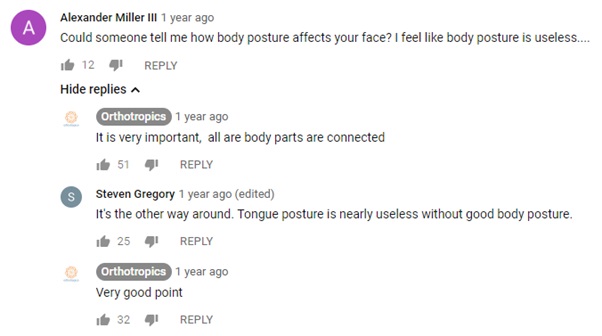
Dr. Mew has mentioned that he likes to teach a rhyme to his patients. The rhyme is “teeth together, lips together, tongue on the roof of the mouth” (31). This exercise allows the tongue to support the maxilla, and therefore promote proper facial development.
Keep in mind that the teeth should only touch very lightly together while doing this exercise (32).
The figure below demonstrates the impact of tongue position on malocclusion.

Dr. Mew claims that he is significantly better looking now compared to how he looked 10 years ago. This is due to him making a conscious effort to keep his tongue up on the roof of the mouth, and chewing more gum (33).
You have to admit that he looks pretty good for someone who is approaching 50 years of age (34).
Why Should I Mew?
While mewing is primarily focused on gaining health improvements, you will notice that health and beauty tend to go hand-in-hand with each other (35). This means that you are likely to see improvements to your facial appearance from mewing also.
Facial identity is primarily based on the maxilla (upper jaw) and the mandible (lower jaw) (36). Having forward maxillary growth will produce a better-looking face (37).
Mouth breathing causes the face to lengthen (or downswing) – leading to a narrow palate, crooked/crowded teeth, and an underdeveloped airway.
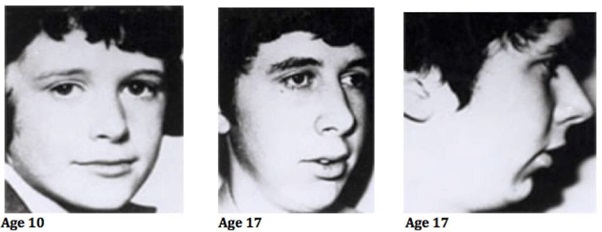
Here is a classic example of an individual who was unable to breathe through their nose due to a complete nasal blockage (38). This blockage was caused by an allergic reaction to a pet gerbil that the child’s Father had brought home for him (39). Keep in mind that that this individual was unaware at the time that the gerbil was causing his allergies to occur.
I think it is pretty obvious that something is clearly not right in the after photo of this individual. You can see that his maxilla has dropped down, and he now has a flaccid lower lip, visible sclera underneath his iris, and recession of his mandible.
In short, he looks like a completely different person compared to what he looked like as a 10-year-old kid in only a 7-year time span.
An unattractive face can promote childhood teasing, which can then result in severe psychological problems down the road for the individual (40). In fact, a high percentage of people who are admitted to psychiatric units are there because they believe their face is unattractive (41).
When the face downswings, the tongue moves closer to the airway. This is important to note as the more down swung you are, the more likely you are to develop sleep apnea (42). Sleep apnea in children is a serious health concern as it can have a negative impact on the individuals IQ, social development, and overall life-expectancy (43).
In fact, obstructive sleep apnea (OSA) is estimated to reduce the life expectancy of a person by 20 years (44).
Derek Mahony, a well-recognized Australian orthodontist, has stated that if you are able to change the airway of a young individual (through arch development, maxillary protraction, etc.) then you can help improve their sleep quality, school performance, and allow them to develop a better-looking face (2).
Keep in mind that the effectiveness of mewing decreases as you get older. It will become increasingly more difficult to see changes after the age of 25 (45). In saying that though, there have been multiple cases of people older than 25 that have achieved significant improvements due to mewing.
Mewing apparently works best for children under the age of 9, but should still work for people at any age. In fact, Dr. Mew believes that the face can change at any age (46). Just take a look at any stroke victim and you will notice that this is true (47).
One example that Dr. Mew likes to use to show that facial change can occur at any age is physicist Stephen Hawking. It is very obvious that his facial appearance changed during the later stages of his life (48).
Surely if people can change in the wrong direction, then they should also be able to change in the right direction… right (49)?
Time is a big factor when it comes to mewing (50). Some people have been able to achieve significant results in only a small duration of time, while others have not been so lucky (51). It may take several years before you begin to notice any significant changes to your facial structure.
Dr. Mew suggests that you will experience facial upswing before you experience symmetry correction (52).
Mewing is definitely not a ‘get-rich-quick’ scheme (so to speak).
How to Mew
One of the most important aspects of mewing is maintaining proper tongue posture. In addition to proper tongue posture, Dr. Mew promotes several other exercises such as the mealtime exercise, tongue chewing, and the abs walk (53).
Dr. Mew states that it can be rather difficult to teach mewing to someone as every person is different (54).
Proper Tongue Posture
Proper tongue posture involves (55):
- Placing the tip of your tongue on your palate, just behind the two front teeth (Figure A)
- You should feel the borders of your tongue touch the inner surfaces of all upper back teeth and gums (Figure B)
- This tongue position should allow you to create a seal between the roof of your mouth and your tongue, such that you could create a clicking sound if you opened your mouth quickly
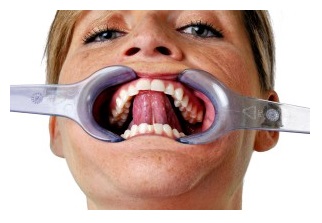
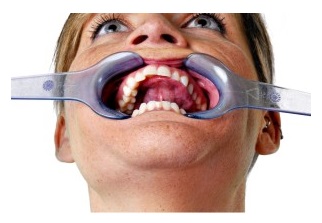
Proper tongue posture can greatly affect the muscle harmony of the jaw and neck and should be protected at all times in order to develop it into an unconscious habit.
Mealtime Exercise
The first exercise on the list is the ‘mealtime exercise.’
The mealtime exercise has several different components to it:
- Body posture (sitting up straight)
- Elbows positioned off of the table (56)
- Tucking your chin in (McKenzie Chin Tuck) (57)
- Drawing the food to your mouth (not bending down to eat) (58)
- Chewing the food thoroughly with your lips sealed (59)
- Engaging the posterior third of the tongue (60)
To perform the mealtime exercise you will want to start off by standing or sitting up straight in your chair. From this position, you will want to bring the food up to your mouth – as opposed to bringing your mouth to the food.
When the food is in your mouth you will want to chew it until it is completely ‘mushed up’ (for lack of a better term) (61).
After the food has been chewed thoroughly, you will want to perform a chin-tuck, which is the act of tucking your chin in towards your neck (62). The McKenzie Chin Tuck will force you to swallow correctly as you consume your food.
When you do this you should be able to feel the back third of your tongue press up against the roof of your mouth as you swallow (63). It is very important to engage the posterior third of your tongue when you are performing this exercise (64).
You should also be able to see/feel your hyoid bone rise up as you swallow if you are performing the exercise correctly (65).
Dr. Mew’s Grandmother once said that you should chew your food 32 times as you have 32 teeth in your mouth. While this may not be completely accurate, I think it is fair to say that we should all be chewing a lot more than we currently do (66).
Tongue Chewing
Tongue chewing is a good exercise that develops the ‘inner U’ of the face. To put it simply, tongue chewing is the act of ‘chewing’ gum using just your tongue (and not your teeth!) (67).
The idea behind tongue chewing is that it should help build up the muscle tone of the tongue – much like how we are able to build up the muscles involved with mastication (68). Resting muscle tone affects posture (69).
When the chewing gum is inside of your mouth you will want to squeeze your tongue up against the roof of the mouth (70). When you do this you will want to position the gum on the roof of your mouth, just before the rugae (the rough area behind the front teeth) (71).
To start this exercise you will want to roll the chewing gum up into a ball in your mouth, and then, using your tongue, you will want to squeeze it up against the roof of the mouth as you push it forwards (72).
Alternatively, you may also want to perform a rolling motion with your tongue (73).
The main goal of this exercise is to try and spread the chewing gum out as much as you can across the roof of your mouth (74).
One important aspect of tongue chewing is that you should try and spread the chewing gum as far back in your mouth as you can in order to engage the back third of your tongue (75).
There are several different types of chewing gum that you may want to experiment with when performing this exercise. Dr. Mew demonstrates this method using regular chewing gum, but you may also want to try falim or mastic gum, which are firmer types of gum that will give the tongue a better workout (76).
CAUTION: You should be careful that you do not accidentally inhale the chewing gum while you are performing this exercise.
The Abs Walk
Dr. Mews video on the abs walk has recently been taken down. Therefore, this exercise will not be covered in this article.
Mouth Breathing
As we have mentioned before, mouth breathing can be associated with a variety of adverse health concerns.
Why is Mouth Breathing Bad?
There are several reasons why mouth breathing is bad for you.
First and foremost, if you breathe through your mouth then you are not able to process the allergens that you inhale in (77). The nose is able to filter out the air that you breathe in – preventing particles (such as pollen) from entering your system.
Mouth breathing is also commonly associated with crooked teeth, gum disease, bad breath, and incorrect facial development.
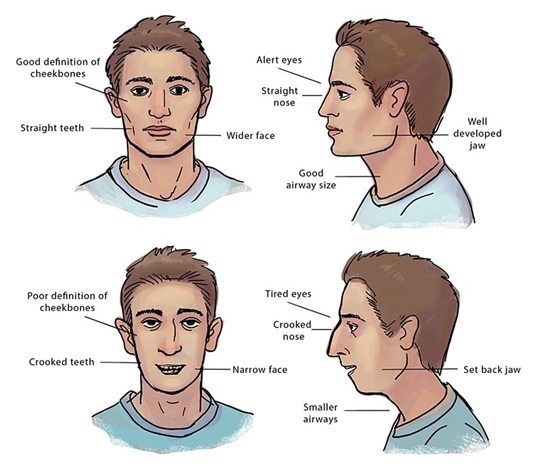
In addition to this, mouth breathing is known to dry out the mucosal tissue inside your mouth, causing a residual film of sticky substance to appear. This substance attracts bacteria that causes bad breath, dental decay, swollen gums, and can induce teeth-grinding (bruxism) (78).
Symptoms
Some of you may not even be aware that you breathe through your mouth at night.
Here is a list of symptoms that you may experience if you do so:
- Dry mouth
- Bad breath
- Fatigue
- Brain fog
- Dark circles underneath your eyes
Keeping your lips sealed at night will allow you to keep your mucosal tissue moist, and reduce the incidence of teeth grinding (79).
Mouth Taping
Taping your mouth shut at night may be a viable option for you to consider if you are unable to keep your mouth shut while sleeping. This will force you to breathe through your nose and not your mouth.
Frank Seaman, a board-certified prosthodontist, has developed some tape that is specifically designed to be worn over your mouth at night. This tape is known as LipSeal Tape and can be purchased here.
Please note that mouth taping can be potentially dangerous if you suffer from any kind of nasal obstruction, such as a deviated septum.
Tongue Push Ups
It’s one thing being able to keep the mouth shut, and another thing being able to keep your tongue up on the roof of the mouth.
One exercise that you may want to try if you are unable to keep your mouth up on the roof of your mouth is known as the ‘tongue push up.’
This exercise involves posturing the tip of your tongue up on the ‘n-spot’ of your palate (80). From here you will want to press up against that spot firmly with the tip of your tongue (81). Doing so will work the intrinsic muscles of the tongue (82).
Do 5 sets of this exercise for 10 seconds each (with some time to relax in between each set). It is particularly important to do this before you go to sleep.
You will know if you have been successful if you can go to sleep after performing this exercise and wake up with your tongue in the exact same position (83)
Malocclusion / Crooked Teeth
Below is a diagram that was published in 2006 that shows the prevalence of malocclusion in the United States. What is interesting about this diagram is that we only know the cause behind 5% of these cases (84).
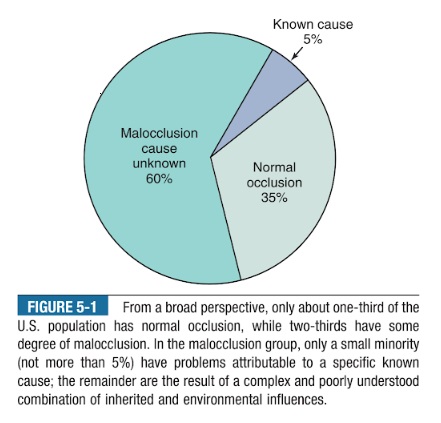
It is obvious that malocclusion is a predominant health concern that affects a large portion of the population, yet we only know a small fraction of the causes behind them (85). Furthermore, the causes that we do know of are usually associated with people with diseases, syndromes, traumas, and infections (86).
The general consensus today is that crooked teeth are an inherited abnormality (87).
There are several theories behind the increasing prevalence of malocclusion seen over the years (88). This includes things such as mixed inheritance, and smaller jaws – both of which do not have much evidence to support these ideas (89).
Dr. Mike Mew believes that there are several likely causes behind malocclusion, which are (90):
- Muscle-usage (a change in muscle usage)
- Mandibular-lingual position (tongue position)
- Swallowing pattern (tongue function)
Below is a picture of two different mandibles of roughly the same length.
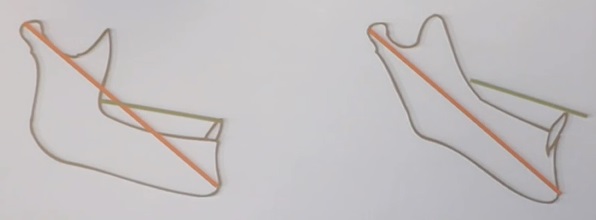
Dr. Mew does not believe that the mandible is getting longer or shorter from treatment or this problem (91). In fact, he believes that it is just the dental space (effective space) that is changing, which is causing there to be less room for the teeth to grow (particularly in the posterior and anterior area of the jaw).
Current Research
There have been a number of different studies that suggest that there is a relationship between nasal airway obstruction and abnormal facial development.
Primate Experiments On Oral Respiration
Harvold conducted a study in 1981 that looked at the relationship between mouth breathing and dental malocclusions.
In this study, Harvold used silicon nose plugs to obstruct the nasal passages of numerous monkeys. As you would expect, this blockage caused the experimental monkeys to develop a mouth-breathing habit in order to survive.
Due to their inability to breathe through their nose, the experimental monkeys began to adopt an open-mouth position
The importance of this study is that ALL experimental monkeys slowly began to develop a facial appearance and dental occlusion different to that from the control group.
Source: Harvold, E.P., Tomer, B.S., Vargervik, K. and Chierici, G., 1981. Primate experiments on oral respiration. American journal of Orthodontics, 79(4), pp.359-372.
Primate Experiments On Mandibular Growth Direction
In 1982, Harvold induced oral respiration in eight growing monkeys. Several things were observed during the study of these monkeys. This includes:
- Lowering of the chin
- A steeper mandibular plane angle
- Increased gonial angle
- Increased facial height
The experimental monkeys exhibited posterior rotation of the mandible, while the control group exhibited anterior rotation.
Source: Tomer, B.S. and Harvold, E.P., 1982. Primate experiments on mandibular growth direction. American journal of Orthodontics, 82(2), pp.114-119.
Another Study
In another study, Harvold took another group of monkeys and attached a piece of plastic to the roof of their mouths (92). This piece of plastic made it uncomfortable for the monkeys to place their tongue on the roof of their mouth and ultimately forced them to keep their tongue down (93).
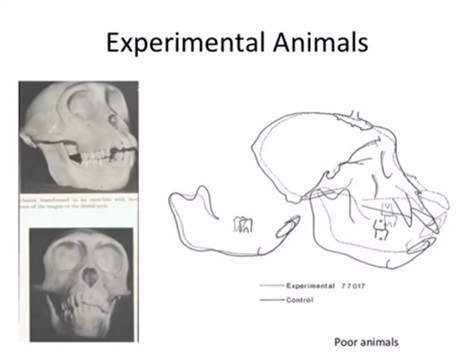
This experiment caused a gross increase in facial height of ALL of the experimental monkeys, and no changes to the control group (94, 95).
Dr. John Flutter
Dr. John Flutter, a dentist of more than 42 years, said that the single most important thing a parent can do to improve a child’s health is to help them establish nasal breathing (96).
He also states that if you fail to establish nasal breathing, then the child will have crooked teeth due to incorrect growth/development of the face and the jaw (97).
Healthy children have (98):
- Their lips together at rest
- Their tongue resting on the roof of the mouth
- They breathe through their nose
- They have no swallow movement on the subconscious swallow
If children grow up with these patterns then they will have straight teeth (99). If they are missing any of these patterns then they will not have straight teeth (100).
Frequently Asked Questions (FAQ’s)
Should I Avoid Getting Teeth Extracted?
Dr. Mike Mew recommends that teeth extractions should be avoided if possible (101). In saying that though, Dr. Mew has also said that teeth extractions are not entirely bad (as seen in the image below).
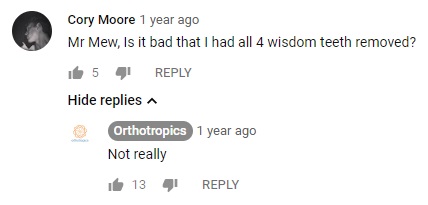
What if I Don’t Have Enough Tongue Space?
It should come as no surprise that if you want to mew then you will need enough tongue space to do so (102).
If you are unable to mew then you may need to use an appliance to get enough room in your mouth for you to do so.
Does Mewing Cause TMJ / TMD?
This is an important question to consider as TMD (temporomandibular joint disorder) can be very debilitating if you suffer from the condition.
(Note: TMD is often referred to as TMJ – named after the joint)
For those of you who are unfamiliar with TMD, it is a condition that causes pain to the joint that connects your mandible to the temporal bones of your skull.
Currently, we are unaware of the exact cause(s) of TMD.
Dr. Mew believes that part of what causes TMD to occur is related to the imbalance between the muscle and the tongue effect (103).
You should be careful if you plan on chewing a lot of gum as this may lead to TMD problems, especially if you are not doing it in conjunction with tongue chewing (104).
Can Mewing Improve Eyesight?
Below is a quote from Dr. Mew that addresses this question:

